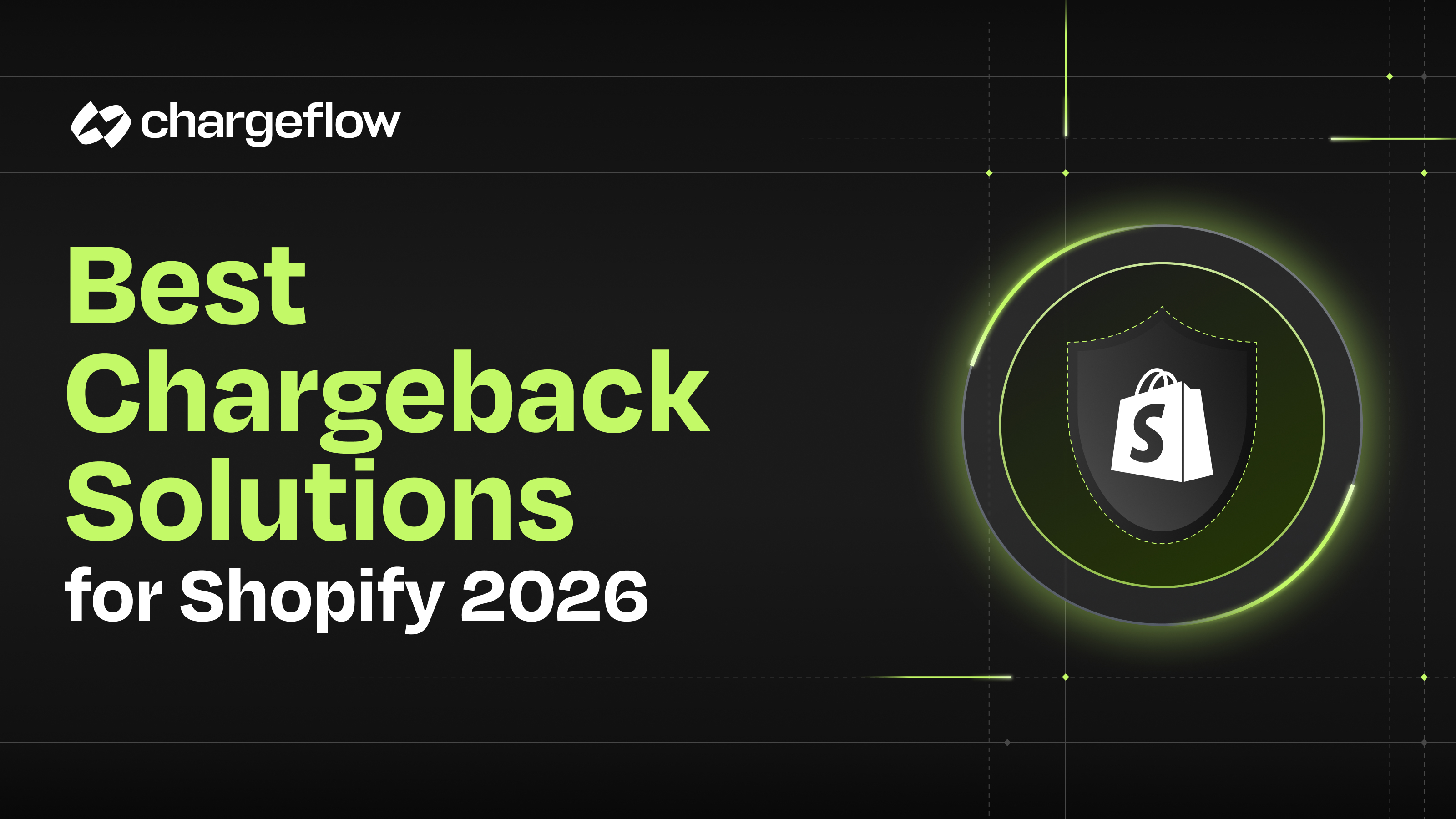5 Essential Fraud Detection Rules Every Merchant Should Know: A Guide to Choosing the Right Fraud Detection Solution

Chargebacks?
No longer your problem.
Recover 4x more chargebacks and prevent up to 90% of incoming ones, powered by AI and a global network of 15,000 merchants.
Protect your business from fraud with these 5 essential fraud detection rules! This guide will help you choose the right fraud detection solution.
Fraudulent activity has become an unfortunate reality of doing business—especially for merchants. With the constantly shifting landscape declared by advances in fraud detection and security, it’s more important than ever for merchants to stay on their toes and ensure they are properly protected from potential threats.
Thankfully, there are five essential fraud detection rules that every merchant should know to help them identify high-risk scenarios and choose the right fraud protection solution for their business.
This guide will review each of these rules, as well as provide insight into which features are essential for a successful defense against fraudulent activity. Armed with this knowledge, merchants can make informed decisions when selecting the right solution and sleep soundly knowing they’ve done all they can to protect their valuable customers and bottom line.
Rule 1: Review High-Risk Orders
Definition of high-risk orders
A high-risk order is an order that presents a greater risk of fraud or chargeback to the merchant. High-risk orders may involve certain types of products or services, certain countries or regions, or certain customer behaviors that are associated with a higher risk of fraud or chargeback.
Techniques for reviewing high-risk orders
- Verify patient information: Ensure that the patient's name, date of birth, and medical history match the order.
- Check for drug interactions: Use a drug interaction database to determine whether the ordered medication may interact with other medications the patient is taking.
- Verify dosage: Double-check the ordered dose against the recommended dose range for the patient's age, weight, and medical condition.
- Check for allergies: Confirm whether the patient has any allergies to the ordered medication or its ingredients.
- Review administration route: Ensure that the ordered medication is appropriate for the intended route of administration (e.g., oral, IV, intramuscular, subcutaneous).
- Involve other healthcare professionals: Seek input from other healthcare professionals, such as pharmacists or physicians, for additional insights or advice.
Benefits of reviewing high-risk orders
- Improves patient safety: Reviewing high-risk orders can help prevent medication errors and adverse drug events, which can improve patient outcomes and reduce healthcare costs.
- Increases staff accountability: Implementing a high-risk order review process can hold healthcare providers accountable for ensuring patient safety and following best practices.
- Enhances quality of care: Reviewing high-risk orders can lead to a higher quality of care by promoting evidence-based prescribing practices and reducing the likelihood of medication-related errors.
Rule 2: Analyze Order Velocity
Explanation of order velocity
Order velocity refers to the speed at which medication orders are entered and processed within a healthcare system. Analyzing order velocity involves examining how quickly orders are received, verified, and filled, as well as how long it takes for the medication to be administered to the patient.
Techniques for analyzing order velocity
- Use technology to track orders: Implement an electronic ordering system that tracks order entry and processing times.
- Analyze data: Use the data collected from the electronic ordering system to identify patterns and trends in order velocity.
- Identify bottlenecks: Pinpoint areas of the ordering process that may be slowing down order velocities, such as verification or filling times.
- Streamline processes: Implement changes to streamline the ordering process, such as automating certain tasks or reallocating staffing resources.
- Monitor progress: Continuously monitor and measure order velocity to ensure that changes have a positive impact.
Benefits of analyzing order velocity
- Improves patient care: Analyzing order velocity can reduce wait times for medication administration, which can lead to improved patient outcomes and satisfaction.
- Increases efficiency: Streamlining the ordering process can reduce delays and errors, which can improve overall efficiency and reduce costs.
- Enhances communication: Analyzing order velocity can identify areas where communication between healthcare providers may be improved, such as between prescribers and pharmacists.
- Facilitates continuous improvement: Regularly analyzing order velocity can help healthcare systems identify areas for improvement and implement changes to continuously enhance patient care and safety.
Rule 3: Check IP Address Geolocation
Definition of IP address geolocation
IP address geolocation is the process of determining the physical location of a device or computer using its internet protocol (IP) address. This information can be useful for identifying potential security threats or fraudulent activity.
Techniques for checking IP address geolocation
- Use geolocation services: Use geolocation services, such as GeoIP, to identify the physical location of an IP address.
- Cross-reference with other data: Cross-reference the geolocation data with other information, such as login times, to identify potential anomalies or suspicious activity.
- Monitor for changes: Continuously monitor IP addresses for changes in geolocation or other suspicious activity.
- Use automated tools: Utilize automated tools, such as intrusion detection systems, to flag potential security threats based on IP address geolocation data.
Benefits of checking IP address geolocation
- Improves security: Checking IP address geolocation can help identify potential security threats, such as unauthorized access attempts or fraudulent activity.
- Prevents fraud: By identifying the physical location of a device or computer, IP address geolocation can help prevent fraudulent activity, such as online scams or identity theft.
- Enhances regulatory compliance: Some industries, such as banking and healthcare, have regulatory requirements for monitoring and tracking IP address geolocation data.
- Supports incident response: In the event of a security breach or other incident, IP address geolocation data can be useful for identifying the source of the threat and taking appropriate action.
Rule 4: Monitor Device Fingerprinting
Explanation of device fingerprinting
Device fingerprinting is the process of collecting and analyzing data points from a device or computer, such as operating system, browser type, and installed plugins, to create a unique digital profile of that device. This information can be used to track the device's activity and identify potential security threats.
Techniques for monitoring device fingerprinting
- Use software tools: Utilize software tools, such as browser fingerprinting extensions, to collect and analyze device fingerprinting data.
- Monitor for changes: Continuously monitor device fingerprinting data for changes, which could indicate potential security threats or fraudulent activity.
- Correlate with other data: Correlate device fingerprinting data with other information, such as login times or IP address geolocation, to identify potential anomalies or suspicious activity.
- Implement security policies: Develop and implement security policies for managing and monitoring device fingerprinting data.
Benefits of monitoring device fingerprinting
- Improves security: Monitoring device fingerprinting can help identify potential security threats, such as unauthorized access attempts or data breaches.
- Prevents fraud: By tracking device activity, device fingerprinting can help prevent fraudulent activity, such as account takeover or identity theft.
- Enhances regulatory compliance: Some industries, such as finance and healthcare, have regulatory requirements for monitoring and tracking device fingerprinting data.
- Supports incident response: In the event of a security breach or other incident, device fingerprinting data can be useful for identifying the source of the threat and taking appropriate action.
Rule 5: Verify Cardholder Information
Explanation of cardholder information
Cardholder information refers to the personal and financial data associated with a payment card, such as a credit or debit card. This information can include the cardholder's name, billing address, card number, and expiration date.
Techniques for verifying cardholder information
- Use Address Verification Service (AVS): Utilize AVS to match the billing address provided with the cardholder's bank records.
- Verify card security code: Verify the Card Verification Value (CVV) or Card Security Code (CSC) provided with the payment card to ensure the card is in the possession of the cardholder.
- Use fraud detection tools: Implement fraud detection tools, such as machine learning algorithms, to identify potentially fraudulent activity based on cardholder information.
- Cross-reference with other data: Cross-reference cardholder information with other data, such as IP address geolocation or device fingerprinting, to identify potential anomalies or suspicious activity.
Benefits of verifying cardholder information
- Reduces fraud: Verifying cardholder information can help prevent fraudulent activity, such as unauthorized use of payment cards or identity theft.
- Improves customer satisfaction: By ensuring that payment transactions are legitimate, verifying cardholder information can help prevent payment errors or delays, which can improve customer satisfaction.
- Enhances regulatory compliance: Some industries, such as finance and healthcare, have regulatory requirements for verifying cardholder information.
- Mitigates financial risk: Verifying cardholder information can help reduce the financial risk associated with fraudulent activity or chargebacks.
How to Choose the Right Fraud Detection Solution?
Choosing the right fraud detection solution can be a tricky endeavor, as there are many aspects to consider. To begin, one must thoroughly research the different products available, and compare their features and benefits side-by-side.
It is also critical to understand the technical requirements of any fraud detection solution one wishes to implement, as well as which scalability options make the most sense for the organization using it.
Aside from the specific technical elements, organizations should assess whether they can manage a particular system in-house, or if they would be better served by a provider that will take care of all setup and maintenance.
Moreover, pricing structures should be taken into account to ensure an affordable, yet effective solution is chosen for the business’s needs. By adequately exploring these factors before deciding on a fraud detection solution, organizations can find one that best meets their goals without overspending on resources or capability gaps.

Chargebacks?
No longer your problem.
Recover 4x more chargebacks and prevent up to 90% of incoming ones, powered by AI and a global network of 15,000 merchants.






























.png)








